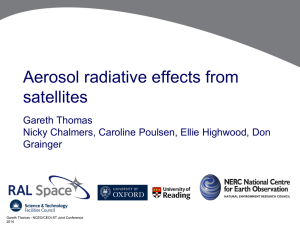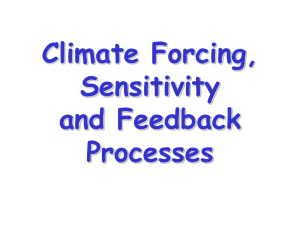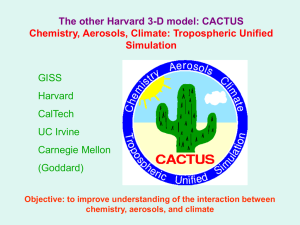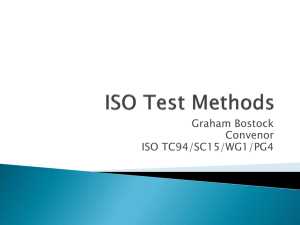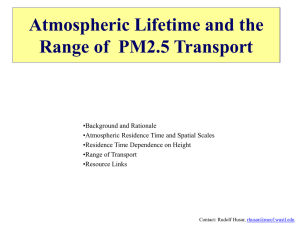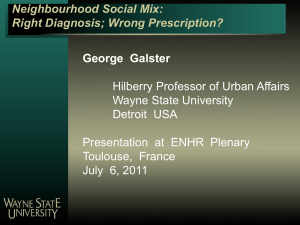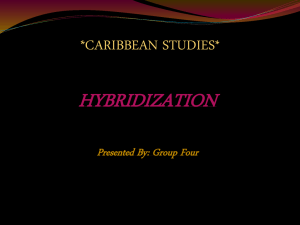rad_bc_mixing_group_meeting_10_1_2014
advertisement
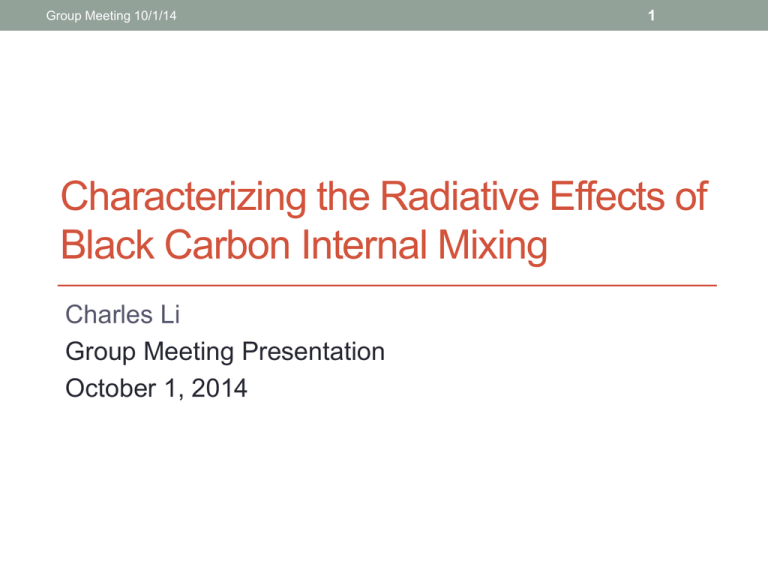
Group Meeting 10/1/14 1 Characterizing the Radiative Effects of Black Carbon Internal Mixing Charles Li Group Meeting Presentation October 1, 2014 Group Meeting 10/1/14 2 Background Black Carbon (BC) Direct Radiative Forcing: • +0.71 W m-2 (+0.08, +1.27) (1750-2005) Bond et al. [2013] • +0.60 W m-2 (+0.2, +1.1) (1750-2010) IPCC-AR5 Large Uncertainties associated with direct radiative forcing of BC! IPCC-AR5 Group Meeting 10/1/14 3 Background Absorption Aerosol Optical Depth (AAOD, τa) MAC = Mass Absorption Coefficient nm = mass concentration Difference of BC AAOD between AERONET observations and AeroCom models. (Koch et al., 2009; Bond et al., 2013) 4 Group Meeting 10/1/14 Background (Oshima et al., 2012; IPCC-AR5) Group Meeting 10/1/14 5 Background (Bond et al., 2013) 6 Group Meeting 10/1/14 Background • Internal mixing between black carbon (BC) and other aerosol species, e.g. sulfate and organic carbon (OC) Credit to Adachi et al. [2010] Group Meeting 10/1/14 7 Background Particle-level observations, due to BC internal mixing, MAC is enhanced by • 1.8 ~ 2 for secondary organic aerosol (SOA) & BC (Schnaiter et al., 2005) • 1.2 ~ 1.6 near large cities (Knox et al., 2009) • 1.4 in biomass burning plumes (Lack et al., 2012) Group Meeting 10/1/14 8 Research Question How does black carbon internal mixing affect aerosol climate forcing? 9 Group Meeting 10/1/14 Background Radiative forcing due to BC internal mixing from model results: Radiation Internal Mixing II: Core Shell Internal Mixing I: Homogeneous • +0.51 W m-2 • +0.50 W m-2 (Lesins et al., 2002) • +0.39 W m-2 (Liao and Seinfeld, 2005) +0.17 W m-2 (Chylek et al., 1995) (Jacobson, 2001) • Internal Mixing III: Maxwell-Garnet (MG) Approximation • BC +0.27 W m-2 (Jacobson, 2001) External Mixing Group Meeting 10/1/14 10 Background • 2 × CO2 : • 2 × Sulfate : • 2 × BC (at different altitudes): (Hansen et al., 2005) Group Meeting 10/1/14 11 Specific Question and Aim I How does BC internal mixing influence surface forcing and atmospheric absorption additional to top of the atmosphere (TOA) radiative forcing? 12 Group Meeting 10/1/14 Background Mie Calculation Radiative Transfer Module AtmosphericChemistry Model Particle-level Radiative Properties Radiative Forcing Aerosol distribution Group Meeting 10/1/14 13 Specific Question and Aim II Is it possible to provide a more efficient framework to study BC internal mixing with reduced complexities? 14 Group Meeting 10/1/14 Method Mie Theory Calculation Comprehensive Radiative Transfer Model Particle-level Radiative Properties Layer-level Radiative Forcing Simplified Radiative Transfer Model • Captures major characteristics; • Saves computational cost; • Examines radiative forcing varied with variables e.g. mixing ratios/states, aerosol species, RH, hygroscopicity. Group Meeting 10/1/14 15 I. DEFINING RADIATIVE FORCING DUE TO INTERNAL MIXING. 16 Group Meeting 10/1/14 Method: GFDL Standalone Radiative Transfer Model • Radiative Properties • Aerosol distribution • Meteorological condition Standalone Radiative Transfer Model Radiative Fluxes (RF) Definition: RF(BC + Sulfate) = RF(All) – RF(no BC & Sulfate) RF(BC) = RF(All) – RF(no BC) RF(Sulfate) = RF(All) – RF(no Sulfate) 17 Group Meeting 10/1/14 Radiative Fluxes: INT vs. EXT Global mean clear-sky radiative fluxes using aerosol climatology in 1999 : Surface Radiative Flux TOA Radiative Forcing BC+Sulfat BC e ≅ BC+Sulfat BC e ≅ Sulfat +e EXT -2.70 -0.94 -1.73 -1.72 INT -3.20 -1.45 -2.22 -1.26 Atmospheric Sulfate Absorption + +0.2 -1.90 0 +0.6 6 -1.44 +0.98 +1.94 18 Group Meeting 10/1/14 Radiative Fluxes: INT vs. EXT Global mean clear-sky radiative fluxes using aerosol climatology in 1999 : Surface Radiative Flux TOA Radiative Forcing BC+Sulfat e BC+Sulfat e EXT -2.70 INT -3.20 BC Sulfat e ≠ -0.94 + -1.73 -1.45 -2.22 RF(BC + Sulfate) -1.72 -1.26 BC Atmospheric Sulfate Absorption ≠ +0.2 + -1.90 0 +0.6 6 -1.44 +0.98 +1.94 = RF(All) – RF(no BC & Sulfate) RF(BC) = RF(All) – RF(no BC) RF(Sulfate) = RF(All) – RF(no Sulfate) 19 Group Meeting 10/1/14 Radiative Fluxes: INT vs. EXT Global mean clear-sky radiative fluxes using aerosol climatology in 1999 : Surface Radiative Flux TOA Radiative Forcing Atmospheric Sulfate Absorption BC+Sulfat e BC Sulfat e BC+Sulfat e BC EXT -2.70 -0.94 -1.73 -1.72 +0.2 0 -1.90 +0.98 INT -3.20 -1.45 -2.22 -1.26 +0.6 6 -1.44 +1.94 20 Group Meeting 10/1/14 Radiative Fluxes: INT vs. EXT Global mean clear-sky radiative fluxes using aerosol climatology in 1999 : Surface Radiative Flux TOA Radiative Forcing Atmospheric Sulfate Absorption BC+Sulfat e BC Sulfat e BC+Sulfat e BC EXT -2.70 -0.94 -1.73 -1.72 +0.2 0 -1.90 +0.98 INT -3.20 -1.45 -2.22 -1.26 +0.6 6 -1.44 +1.94 21 Group Meeting 10/1/14 Global mean clear-sky radiative fluxes using aerosol climatology in 1999 +0.46 Wm-2 Radiative Fluxes: INT vs. EXT -0.50 Wm-2 22 Group Meeting 10/1/14 Nonlinear effect due to internal mixing • Previous studies: α ≅ 2 (Jacobson, 2001) α ≅ 1.3 (Bond et al., 2011) 23 Group Meeting 10/1/14 Nonlinear effect due to internal mixing Clear-sky TOA Each color has 8 marks denoting RF based on model year 1860,1890,1910,1930,1950,1970,1990,1999. 24 Group Meeting 10/1/14 Nonlinear effect due to internal mixing • Assumption behind previous studies: • Actually, in the case of BC and sulfate mixing: nonlinear cross term! Group Meeting 10/1/14 25 II. CHARACTERIZING INTERNAL MIXING ON PARTICLE LEVEL 26 Group Meeting 10/1/14 Mie Calculation: BC/Sulfate Mixing Simulations Difference in Calculation Ext. Mixing Mix of radiative properties (BC, Sulfate+water) post MIE Int. Mixing Mix of Refractive Indices (BC, Sulfate+water) before MIE Magnitude of estimations: External Spherical & Aggregated < Core/shell & MG < Homo. Internal Homogeneous Mixing (Lesin et al., 2002; Bond et al., 2006; Jacobson, 2006) 27 Group Meeting 10/1/14 Radiative Properties Of The Particles MAC MSC 28 Group Meeting 10/1/14 Radiative Properties Of The Particles Effect of internal mixing at the particle level: • Slight increase in extincetion • Enhanced absorption • Reduced scattering • Forward scattering Group Meeting 10/1/14 29 III. CHARACTERIZING INTERNAL MIXING ON LAYER LEVEL Group Meeting 10/1/14 30 Relationship between particle-level and layer-level effects Mie Calculation λ—wavelength, RH—relative humidity, σ—mass ratio Two-layer Simplified RTM Group Meeting 10/1/14 31 Radiative Properties Of The Aerosol Layer • Absorbance dominates the difference between layerlevel radiative properties of INT vs. EXT • MAC is the key particlelevel factor that determines this difference. 32 Group Meeting 10/1/14 Method: Simplified Radiative Transfer Model Radiative Properties Mie Calculation Radiative Fluxes Standalone Radiative Transfer Model GFDL Climate Model • Aerosol distribution • Meteorological condition Two-layer Simplified RTM Radiative Forcing 33 Group Meeting 10/1/14 Method: Simplified Radiative Transfer Model Top of Atmosphere F0—insolation One Dimensional Two-layer Aerosol Radiative Transfer Model … Ac—cloud fraction Ta—transmittance … Aerosol Layer Multi-scattering … Surface Rs—surface albedo Radiative properties of the aerosol layer: t—transmittance a—absorbance r—reflectance. (Chylek and Wong, 1995) Group Meeting 10/1/14 34 Simplified Radiative Transfer Model • Assumption I: eliminate high-order term • Approximated radiative fluxes: Group Meeting 10/1/14 35 Simplified Radiative Transfer Model • Radiative forcing due to internal mixing: Group Meeting 10/1/14 36 Simplified Radiative Transfer Model • As was shown • Then, effects of internal mixing will be 37 Group Meeting 10/1/14 Simplified vs. Comprehensive Model Clear-sky Clear-sky Each color has 8 marks denoting RF based on model year 1860,1890,1910,1930,1950,1970,1990,1999. Group Meeting 10/1/14 38 Simplified vs. Comprehensive Model Assume Rs falls between 0.3 and 0.4, • Simplified model well captured the relative magnitude of radiative energy. • Internal mixing evenly captures extra energy from TOA (positive RF) and surface (negative RF), while retaining them in the atmosphere. Group Meeting 10/1/14 39 Particle-level Absorption Enhancement In most source regions, sulfate mass ratio is between 80% and 98%: 40 Group Meeting 10/1/14 Absorption Enhancement Comprehensive model: Particle-level: Simplified model: Each color has 8 marks denoting RF based on model year 1860,1890,1910,1930,1950,1970,1990,1999. 41 Group Meeting 10/1/14 Radiative Fluxes due to internal mixing F0 = 342 W m-2 Ta = 0.79 Rs = 0.45 Group Meeting 10/1/14 Important Role Of Water 42 Group Meeting 10/1/14 Missing role of OC Aerosol mass concentration over West Africa in model year 1999 43 Group Meeting 10/1/14 44 IV. THREE-SPECIES INTERNAL MIXING: BC, SULFATE AND OC 45 Group Meeting 10/1/14 Three-species internal mixing Mixing All EXT Description BC, Sulfate(+water), and OC(+water) are all externally mixed BCSUL INT BC and Sulfate(+water) are internally mixed, while OC(+water) is externally mixed with them. All INT BC, Sulfate(+water), and OC(+water) are all internally mixed σsul—mass ratio of sulfate to BC σoc—mass ratio of OC to BC Group Meeting 10/1/14 46 Three-species internal mixing: MAC 47 Group Meeting 10/1/14 Changing OC/BC Mixing Ratio • When changing OC mixing ratio towards BC, normalized RF calculated by BCSUL INT is a good approximation to All INT 48 Group Meeting 10/1/14 Changing BC/Sulfate Mixing Ratio • The difference between BCSUL INT and All INT is susceptible to changing Sulfate/BC mixing ratio. 49 Group Meeting 10/1/14 Changing BC/Sulfate Mixing Ratio • Consider the global mean column density of the three species together as about 7 mg m-2. • Then, if we assume σsul = 80%, the bias between All INT and BCSUL INT is Unnegligible! compared with the bias between BCSUL INT and All EXT Group Meeting 10/1/14 50 Summary of current results • Internal mixing evenly captures extra energy from TOA and surface, while retaining them in the atmosphere. • Enhancement of the absorbing ability (a factor of 2~3) is the dominant factor in determining the difference between INT and EXT. • Effects of internal mixing is strongest at mass mixing ratio of 60% sulfate, and has an important contribution from water. • Internal mixing significantly enhances and alters vertical heating profile, that may result in hydrological response. • Three-species internal mixing has an important contribution, especially for studying the changing sulfate/BC mixing ratio. Group Meeting 10/1/14 V. LIMITATIONS 51 Group Meeting 10/1/14 52 Limitations From instantaneous radiative forcing to effective radiative forcing: • Fast feedbacks—semi-direct effects on clouds • Missing component in the current framework: vertical heating profile due to internal mixing 53 Group Meeting 10/1/14 Possible fast feedbacks Vertical heating rates Forcing: • Strong atmospheric heating at 750mb and near surface Possible effects: • Enhanced convection near surface • Prohibited convection beyond 750mb • Increased low cloud at 800 mb Group Meeting 10/1/14 54 Follow-up work (current project) • Implement internal mixing between three aerosol species: BC, sulfate and OC in the radiative module of the GFDL climate model. Group Meeting 10/1/14 THANK YOU! 55
